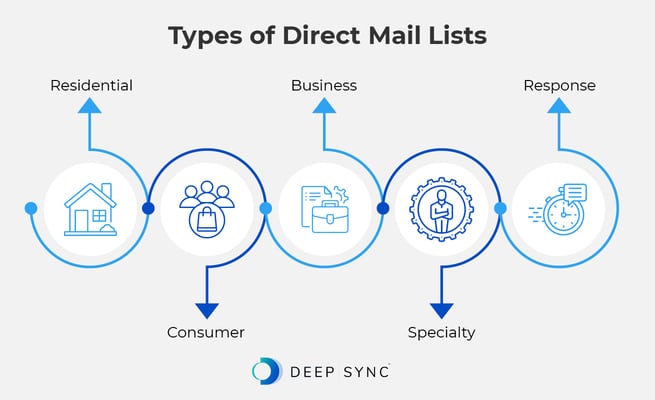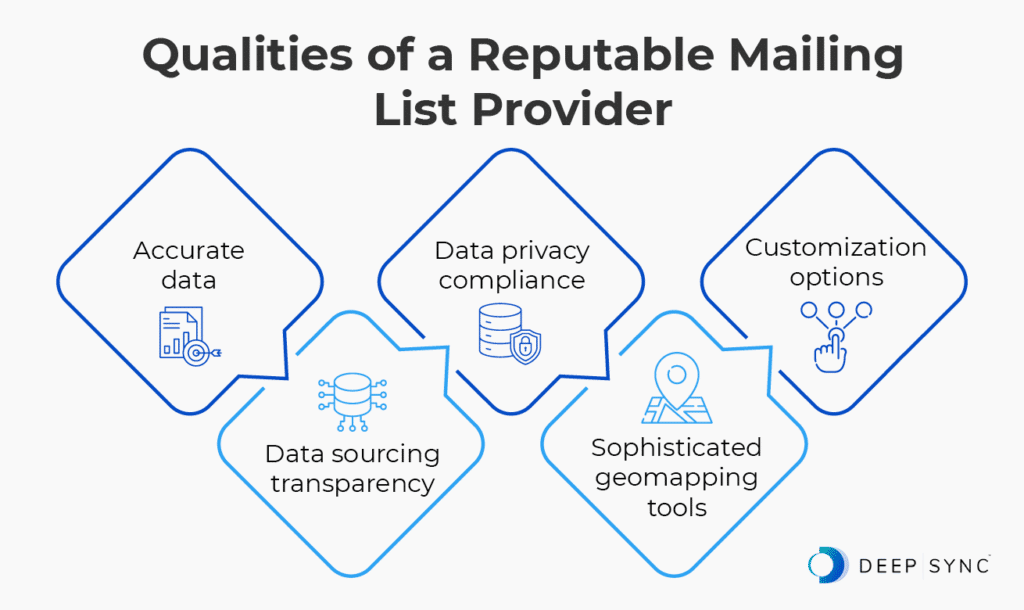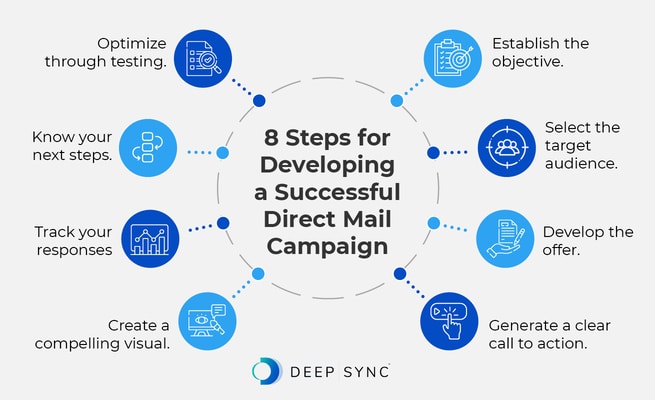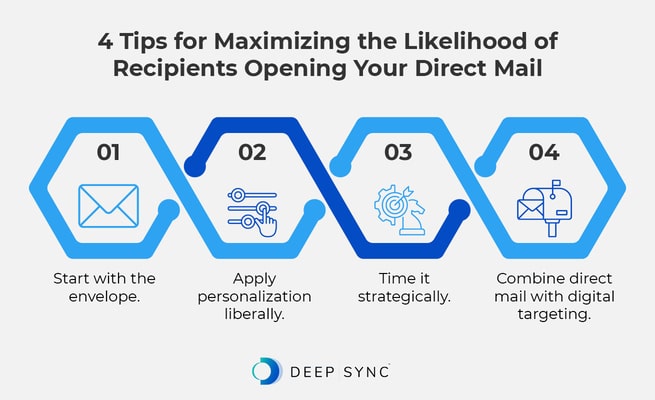In our digital world, it can be easy to overlook more traditional marketing strategies like direct mail. However, marketers are increasingly recognizing the effectiveness of direct mail, with 61% increasing their direct mail investments in 2024. Direct mail creates a tangible connection between your brand and the recipient, helps build brand awareness, and enables you to reach your audience reliably.
Even amid rising postal costs, direct mail is a worthy investment, especially considering it has the highest return on investment (ROI) for individual media at 161%. To make the most of this channel, you need data that enables you to reach your target audience and ensure they receive your messages.
That’s where direct mail lists come in. In this guide, we’ll explore direct mail lists and how they can help you launch successful campaigns by covering these topics:
- What Are Direct Mail Lists?
- What Are the Benefits of Using Direct Mail Lists?
- What Are the Most Common Types of Direct Mail Lists?
- How Can Marketers Obtain Direct Mail Lists?
- How Do Compilers Keep Lists Clean?
- How Can You Find a Reputable Direct Mail List Provider?
- What Type of Response Rate Should Marketers Expect Using Direct Mail Lists?
- 8 Steps for Developing a Successful Direct Mail Campaign
- Maximizing the Likelihood of Recipients Opening Your Direct Mail: 4 Tips

What Are Direct Mail Lists?
Direct mail lists are lists of physical addresses for members of your target audience, so you can reach them with your campaigns. Some types of direct mail lists also contain other attributes, like demographics or interests, that enable you to personalize your communications to their needs.
What Are the Benefits of Using Direct Mail Lists?
By using direct mail lists to power your direct mail campaigns, your business can experience the following benefits:

- Precise targeting. Instead of sending messages to all prospective customers (some of whom will likely find the information more relevant than others), you can reach specific audiences based on attributes like location, demographic, lifestyle, firmographic, and behavioral factors.
- Higher response rates. Since direct mail communications are targeted at specific individuals, households, and businesses, they can receive more responses than generic communications and increase ROI.
- Tangible way to reach customers. Among all of the digital messages your customers receive, direct mail stands out. It serves as a physical reminder of your brand and forges deeper connections.
- Better personalization. By leveraging direct mail lists and segmentation, you can tailor direct mail messages so they speak to your prospective customers’ needs and preferences.
- Easier reach. With direct mail, there’s no need to worry about third-party cookie depreciation, email deliverability issues, or ad blockers. As long as you have correct addresses from direct mail lists, you can be confident that your messages will reach your intended audience.
- Stronger omnichannel campaigns. Adding direct mail to your mix of marketing tactics can strengthen your campaigns and help your messages stick with your target audience. When combining direct mail and digital marketing, marketers see average conversion rates of 40%, and 60% of marketers report increased ROI.
Leveraging direct mail lists helps you reach your audience with targeted messages through a channel known for its high response rates and ROI. As a result, you’ll better engage prospective customers and convert them.
What Are the Most Common Types of Direct Mail Lists?
Different types of direct mail lists enable you to reach different audiences. The main types of direct mail lists include:

Residential Direct Mail Lists
Residential mailing lists, also known as resident/occupant (res/occ) data, enable marketers to reach virtually every mailable residential address within a given geographical area. Resident data is ideal for spreading the news about a new shop in the neighborhood or sending coupons to drum up sales for service-based businesses, such as a nail salon or handyman company.
Common attributes for residential mailing lists include:
- Route Saturation
- Residential Addresses
- Business Addresses
- Mapping
- Postal Presorts
- Enhanced Occupant Data
- Contact Names (Where Available)
Consumer Direct Mail Lists
Consumer lists enable you to focus your direct mail campaign on a specific audience based on demographic, lifestyle, psychographic, and transactional attributes. These databases of economically active households are commonly compiled from buying activities, transactional data, county assessor and recorder data, packaged goods manufacturers, product and warranty registrations, telephone directories, and consumer surveys.
Attributes for consumer direct mail lists may include:
- Age
- Marital Status
- Presence of Children
- Education
- Occupation
- Hobbies or Interests
- Household Income
- Household Composition
- Net Worth and IPA
- Modeled Credit
- Mortgage Attributes
- Pet Ownership
- Property Attributes
Business Direct Mail Lists
If you’re conducting a B2B campaign, this type of list helps you identify businesses that are a good fit for your products or services and reach them via direct mail. Providers frequently compile business data from sources like annual reports, business directories and publications, corporate websites, new business filings, utility connections, and yellow page listings.
You may request attributes like:
- Job Titles/Functions
- Location Type
- NAICS/SIC Codes
- Nonprofits
- Number of Employees
- Office Expenses
- Sales Volume
- Years in Business
Specialty Direct Mail Lists
Specialty direct mail lists identify consumers and businesses based on specific niche attributes. They enable you to advance your targeting efforts beyond traditional B2C and B2B list options to identify various highly-focused prospect segments. Directory assistance data, industry publications, professional directories, and state occupation licenses are commonly used compilation sources for specialty lists.
Examples of specialty direct mail lists may include:
- Pre-Movers, New Movers, and New Homeowners
- Professional Contacts
- Doctors or Nurses by Practice Type
- Voters by Party
- Teachers by Grade or Subject
- College Students
Response Direct Mail Lists
Response lists, also referred to as managed lists, enable you to pinpoint consumer and business segments based on their habits, interests, and purchasing behaviors. The cornerstone of response data is recency, frequency, and monetary value (RFM) spending characteristics that can be an excellent predictor of an audience’s future needs.
Types of response data may include:
- Donors by Dollar Amount
- Donors by Source of Donation
- Catalog Purchasers
- Catalog Recipients by Title
- Magazine Subscribers by Title
- “As Seen on TV” Product Buyers
- Online Product Purchases
- Opportunity Seekers
- Consumers with Online Gift Registries
- Opt-In Email Files
- Ailment-Related Buyers
How Can Marketers Obtain Direct Mail Lists?
You can obtain direct mail lists directly from list compilers or trusted partners that have relationships with these compilers. Once you find a provider, you can purchase lists on your own through online platforms or with the support of a direct marketing expert. By working with a direct marketing expert, you can ask questions about which type of list is best for your goals and receive guidance throughout the list-purchasing process.
You may receive your lists through an instant download or an FTP link. Standard file formats include:
- ASCII Fixed
- CSV (Excel File)
- CSV with Header Row
- Comma-Delimited Text File
- Tab Delimited Text File
Once you receive the file, you can easily integrate it into your printing process.
How Do Compilers Keep Lists Clean?
Quality data providers regularly apply data hygiene and suppression practices. These processes keep address information current and help prevent undesirable profiles from entering the marketing stream.
Common data hygiene best practices include:
Hygiene Services
- CASS™ processing, which standardizes addresses to meet USPS® requirements while correcting ZIP Codes and adding other key address elements as needed
- NCOALink® processing, which aids in compliance with Move Update guidelines when applying new addresses for individuals, families, and businesses that have moved and filed a change of address with the Post Office
- LACSLink® processing, which identifies addresses that have been converted by local authorities, as well as those that have been renamed or renumbered
- DSF2® processing, which improves the deliverability of mailing addresses by validating individual delivery points, identifying business from residential addresses, and more
Suppression Services
- Bankruptcy suppression, which removes individuals or businesses that have filed for bankruptcy
- Deceased suppression, which removes deceased individuals to prevent unwanted mail from being delivered to the decedent’s family
- Do Not Mail suppression, which identifies the names and addresses of consumers who have registered with the ANA’s DMAChoice™ Program to stop receiving any direct marketing solicitations
- Opt-out suppression, which removes addresses from customers who have opted out directly with the data provider
- Prison suppression, which removes addresses associated with federal prisons, state prisons, county correctional facilities, and city jails throughout the United States
Different providers have different timelines for how often they clean their data. In the majority of cases, Deep Sync’s datasets are updated monthly. There are some exceptions specific to our move-related and new homeowner offerings, which are updated more frequently to ensure the freshest, most relevant data is available to our clients.
How Can You Find a Reputable Direct Mail List Provider?
Like with any type of third-party data you obtain for marketing purposes, you’ll want to do your research to find a reliable direct mail list provider. When reviewing your options, check to ensure each potential partner has the following:

- Accurate data. Accurate, high-quality data sources are essential for effective direct mail list development. Ask potential providers about their data hygiene and updating processes.
- Data sourcing transparency. Investigate how and where providers source their data. They should be open about their processes and able to explain the ethics they adhere to in their approach.
- Data privacy compliance. Ensure providers follow all relevant data privacy regulations and confirm which ones they abide by. Their websites should display compliance markers like CCPA compliance and SOC 2 Type II compliance badges, as well as their company’s privacy policy. Lastly, your provider should collect opt-outs and remove consumers and businesses who do not want to be contacted.
- Sophisticated geomapping tools. The accuracy and precision of the location-based data used to compile direct mail lists depend on your provider’s geomapping tools. The more effective these tools are, the better you can identify target audiences that will meet your marketing needs. For example, Deep Sync uses mapping technology called GEO-Direct, which features a custom polygon tool that enables you to map out your target area and gain access to accurate addresses, demographics, mail carrier routes, and other important information.
- Customization options. Each business has its own direct mail needs. Ensure your provider takes the time to understand your goals and can shape their approach to help you accomplish these objectives.
Additionally, you’ll want to work with a data provider with direct mail expertise. For instance, Deep Sync has been compiling direct mail-grade datasets for 35 years and specializes in privacy-compliant data and audience targeting solutions.
What Type of Response Rate Should Marketers Expect Using Direct Mail Lists?
Over the past several years, direct mail response rates have been steadily increasing. This trend is likely due to several factors, including the integration of multiple channels to amplify overall campaign effectiveness and increase response rates. Other relevant factors include increased personalization and the ability to physically interact with the mail piece itself.
According to the ANA’s 2023 Response Rate Report, marketing executives reported a 15.6% response rate for campaigns utilizing house lists and a 10.8% response rate for prospect lists. However, while compelling, these results were generated from a small sample size and should only be considered for informational purposes.
Industry experts generally agree that when you base a direct mail campaign on third-party list data, you can anticipate a response rate of 0.5-2%. When you use first-party data, the response rate tends to be somewhat higher.
8 Steps for Developing a Successful Direct Mail Campaign
Combining your direct mail lists with a cohesive strategy will maximize their effectiveness. Follow these steps to develop a successful campaign:

- Establish the objective. Outline the primary objective of your campaign and how you will measure your success. For example, your goal may be to promote a new product, and you may measure your success based on conversion rates.
- Select the target audience. Determine who your intended audience is and their attributes or characteristics. This step will help you choose the right direct mail list.
- Develop the offer. Generate excitement by creating a relevant offer with a high perceived value. If you’re promoting a new product, explain why it stands out from other offerings on the market, for instance.
- Generate a clear call to action. Tell your recipients exactly how to respond to your message, whether by following your brand’s social media accounts, signing up for your newsletter, making a purchase, or something else. Include an expiration date to encourage them to act quickly.
- Create a compelling visual. Leverage high-quality design, copywriting, materials, and printing to engage customers and make a positive impression.
- Track your responses. Having a system to track responses will enable you to calculate conversions.
- Know your next steps. Create a follow-up plan that includes additional touchpoints to keep building brand awareness.
- Optimize through testing. Test small changes to see how they improve your overall results. For example, you may test responses to different-colored text or imagery.
With a straightforward strategy, you can run campaigns systematically and continuously improve upon your direct mail results.

Maximizing the Likelihood of Recipients Opening Your Direct Mail: 4 Tips
While direct mail is an effective way to reach your audience, that doesn’t mean every message will land. First, recipients have to feel compelled to open your direct mail materials.
Experiment with these tips to ensure audience members read and engage with your messages:

1. Start with the envelope.
The first step in attracting recipients’ attention is delivering a design that sets the mail piece apart. For instance, you may send a colored envelope and print your letter on matching paper, enclose a sample or premium to add volume and weight to the envelope, use a padded mailer to pique the recipient’s interest, or send an oversized postcard that is printed in color on both sides.
2. Apply personalization liberally.
Personalization enables you to create mail pieces that have a “one-to-one” appeal as opposed to that of standard mass mail pieces. Test strategies like using the consumer’s name within the messaging, varying the imagery based on the recipient’s demographics or interests, adjusting the messaging to appeal to the audience’s needs, and hand-addressing each envelope.
3. Time it strategically.
Your mailings themselves may stand out, but sending them at the right time ensures recipients open and read them. If possible, try to avoid sending direct mail around weekends and holidays, and instead coordinate timing with seasonal campaigns or events that can help your messaging stick. You may also send direct mail based on timely behaviors like visiting your website or purchasing a new product.
4. Combine direct mail with digital targeting.
Direct mail is more effective when it’s paired with digital marketing. By leveraging cross-channel tactics like QR codes and social media retargeting, you can develop stronger campaigns that boost conversions, increase engagement, and improve direct mail ROI.
Final Thoughts
Direct mail is a highly effective marketing channel when you have the right data to fuel it. With direct mail lists, your business can precisely target its ideal audiences, increase response rates, and launch cross-channel campaigns that maximize ROI.
To create and implement your own direct mail lists, look no further than Deep Sync. With 35 years of experience in compiling direct mail-grade datasets, assured compliance with all relevant privacy regulations, and more than 1,500 attributes available for customization purposes, Deep Sync is the ideal direct mail list provider. If you’re ready to reach your audience via direct mail, contact us today.
To learn more about the power of direct mail, check out these additional resources:
- Direct Mail in 2025: Statistics and Tips for Success. Explore why direct mail is so impactful and how to set up your campaign for success.
- Residential Mailing Lists: What Marketers Need to Know. Dive deeper into residential mailing lists and how you can leverage them.
- Purchasing and Using Consumer Lists: The Ultimate Guide. To learn more about consumer lists, check out this ultimate guide.














0 Comments